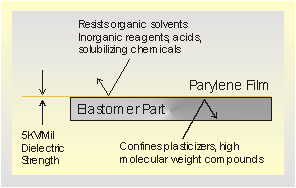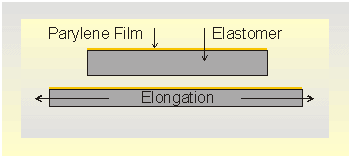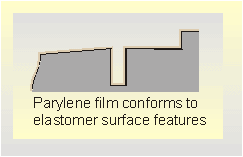
| 印刷電路板 | ||
| 醫療應用 | ||
| 磁芯上的應用 | ||
|
|
橡膠上的應用 | |
| 微電子/微馬達 | ||
產品與技術 > 橡膠應用
光纖光纜接頭在使用中可能遇到各種不同的環境,通常使用含有矽橡膠密封圈的接頭使光纜與環境隔離,經聚對二甲苯塗敷後的矽橡膠密封圈,能更好地適應各種惡劣環境,防止矽橡膠老化,有效延長密封圈的使用壽命,維持光纖光纜能在各種環境下長期使用,這在國外也已使用多年。
Parylene: A Highly Effective and Efficient method for coating Rubber and Silicone Products
Parylene provides a barrier against leaching of elastomer bi-products and protects elastomer surfaces from organic solvents and inorganic reagents, acids and saline solutions.
Parylene substantially improves surface lubricity or
slippery-ness.
Parylene reduces surface tack and stickiness.
Parylene protects surfaces from oils, dirt and contamination.
Prevents flaking or dusting of the elastomer surface.
Adds electrical insulation with dielectric strength greater than 5,000 volts per mil of coating thickness.
Beneficial Properties to the Rubber/Silicone Industry
Parylene coating establishes a barrier that can prevent the transfer of substances into or out of the coated substrate, even when the film layer is only one to two microns in thickness. High molecular weight elastomer compounds such as silicone plasticizers are restricted from leaching out by the film barrier, and the coating also prevents solubilizing chemicals from intruding into an elastomer from the outside (Below: Parylene film forms a barrier on coated elastomer substrates).

This coating resists chemical attack from organic solvents and inorganic reagents, acids or saline solutions, and contributes electrical insulation with a dielectric strength greater than 5,000 volts per mil of coating thickness (Below: Parylene elongates with elastomer substrate).

The chemical structure of Parylene film determines its unique performance capabilities for this and other coating applications. It has high molecular weight, a crystalline form, and an all-carbon backbone. The absence of polar entities in the essential molecular makeup of the Parylenes makes these polymers quite hydrophobic, stable, and resistant to chemical attack. In contrast, other polymeric coating systems have oxygen, nitrogen or sulfur atom links in their backbone structures, and may require cross-linking to achieve the desired properties. This makes them more vulnerable to solvents and chemical degradation. Some may also contain solvents, fillers, stabilizers, plasticizers or other potentially mobile components that could out-gas or be extracted in use.
Parylene film elasticity and surface adhesion integrity enables the coating to handle substantial elongation of the underlying elastomer without fracturing or breaking the film-to-substrate bond.
Parylene reduces elastomer tack and surface stickiness without adding stiffness to the to the part. This is a useful property for the rubber keypads used on calculators, cell phones and other devices. In this case, the film prevents dirt and oils from penetrating the keypad surface, and it protects printed legends and preserves keypad appearance.
The film also adds chemical protection to rubber keypads, including resistance to petrochemicals and solvents. In some cases it may be possible to substitute a conventional rubber keypad for a more costly and higher performance fluoroelastomer by coating the rubber with Parylene. The applied film does not compromise the electrical insulating properties of underlying rubber components.
The barrier performance and chemical inertness of Parylene are particularly useful for biomedical objects such as catheters or single-use medical instrumentation items with rubber seals, plungers or diaphragms. Substrates such as these may come in temporary or prolonged contact with human tissues, and could otherwise be compromised. Two of the Parylenes, N and C, are certified to comply with USP biological testing requirements for Classification VI, including Acute Systemic Toxicity, Intracutaneous Toxicity, and Implantation.
Parylene's static and dynamic coefficients of friction, which are in the range of 0.25 to 0.33, allow coated elastomers to approach the dry film lubricity of PTFE (Teflon®). For example, tiny lead wires used inside flexible medical catheters must be both electrically insulated and chemically protected. The excellent dry film lubricity of Parylene coating allows such surfaces to move easily in tight quarters. The external surfaces of rubber catheters also benefit functionally from coating lubricity.
The coefficient of friction for Parylene C, as measured by ASTM D 1984, is 0.29 for both static and dynamic observations.
 One of the most important distinguishing
features of vacuum polymer deposition compared to conventional liquid
coatings is the absence of surface tension, meniscus, bridging or pooling.
This unique property is due to the fact that Parylene is deposited as a
gas at the molecular level rather than as a liquid. Vacuum deposition
results in a very high degree of coating conformality - with essentially
equivalent coating thickness deposited simultaneously on flat surfaces,
over inside and outside corners, and in deep crevices
(Above-right: Parylene is deposited evenly on flat
surfaces, edges, and in crevices).
One of the most important distinguishing
features of vacuum polymer deposition compared to conventional liquid
coatings is the absence of surface tension, meniscus, bridging or pooling.
This unique property is due to the fact that Parylene is deposited as a
gas at the molecular level rather than as a liquid. Vacuum deposition
results in a very high degree of coating conformality - with essentially
equivalent coating thickness deposited simultaneously on flat surfaces,
over inside and outside corners, and in deep crevices
(Above-right: Parylene is deposited evenly on flat
surfaces, edges, and in crevices).
The mechanical dampening and loading effects of Parylene are minimal in any application because of coating thinness and because there is no conventional cure force or phase change. This coating is used with many substrates in addition to elastomers, including glass, metal, paper, resin, plastics, fiberglass, ceramic, ferrite and silicon, and even powdered and granular substances.
The Parylene Coating Process
Because Rubber and Silicone parts are generally coated in a
continuous tumbling process which exposes all surfaces to the Parylene
monomer, Parylene coating rubber and silicone parts can be extremely cost
efficient (Below: Parylene tumble coating of unfixtured
parts using SCS patented chamber coater).

No part fixturing is required with tumble coating, and this process makes efficient use of the Parylene raw material (Larger parts, and parts that require masking for selective coating may need to be fixtured in the coating chamber).
The cure cycle is automatic with Parylene and actually occurs before the film is deposited. For this reason, substrates are not subjected to cure forces or elevated temperatures, and no testing is required to confirm that full cure has occurred.
Conclusion
Vacuum-deposited Parylene film can improve the surface
properties of rubber substrates in ways that cannot be achieved with other
materials or processes. Its application is controllable, and the process
provides consistent, repeatable cost effective results.
Copyright and Disclaimerc © Xuan Bao Hao Corp. 隱私保護及安全聲明 | 智慧財產權 請使用IE 4.0以上版本之瀏覽器